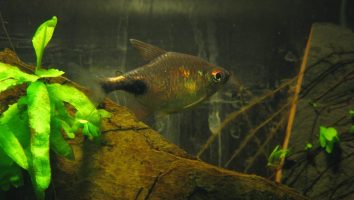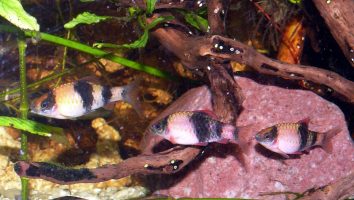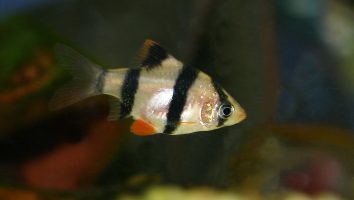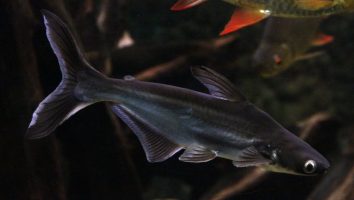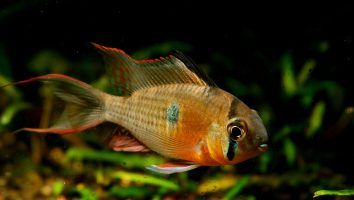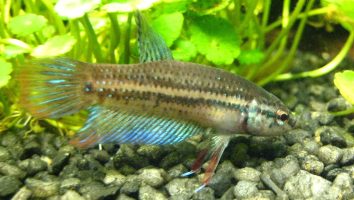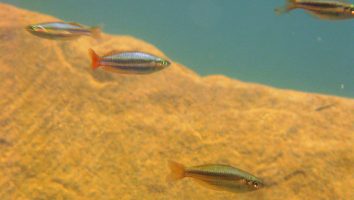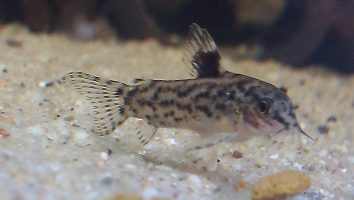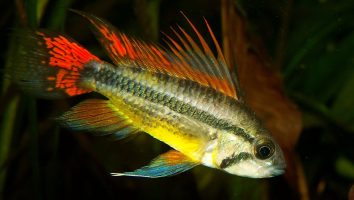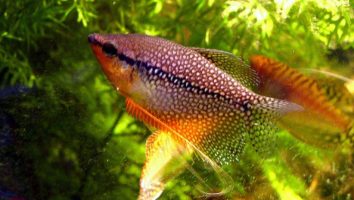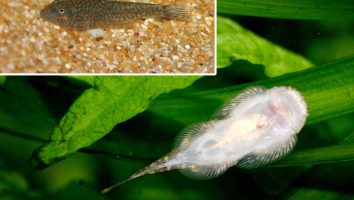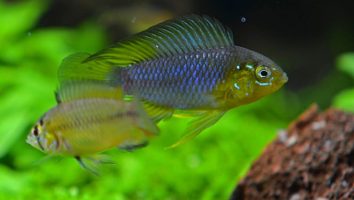The eyespot rasbora is a beautiful and peaceful freshwater fish that makes a great addition to any community tank.
This species is relatively easy to care for, and can even thrive in less-than-ideal water conditions.
But like all fish, they do have some specific requirements when it comes to diet, tank mates, and more.
In this guide, we’ll teach you everything you need to know about eyespot rasbora care. You’ll learn about their diet, size, lifespan, and more!
Table of contents
Species overview
Eyespot rasboras (Trigonostigma espei) are native to Malaysia and Thailand where they can be found living in slow-moving streams and rivers.
They have a very unique appearance due to the black “eye spot” on their caudal peduncle. This eye spot is used to startle predators and help the fish escape danger.
In the wild, these fish are omnivores but tend to eat mostly insects and other small invertebrates. They are a peaceful fish that can get along with most other tank mates.
Eyespot rasboras are a popular choice for nano aquariums because of their small size and peaceful nature. They are also one of the few fish that can tolerate brackish water conditions, making them a versatile choice for many different types of tanks.
Appearance
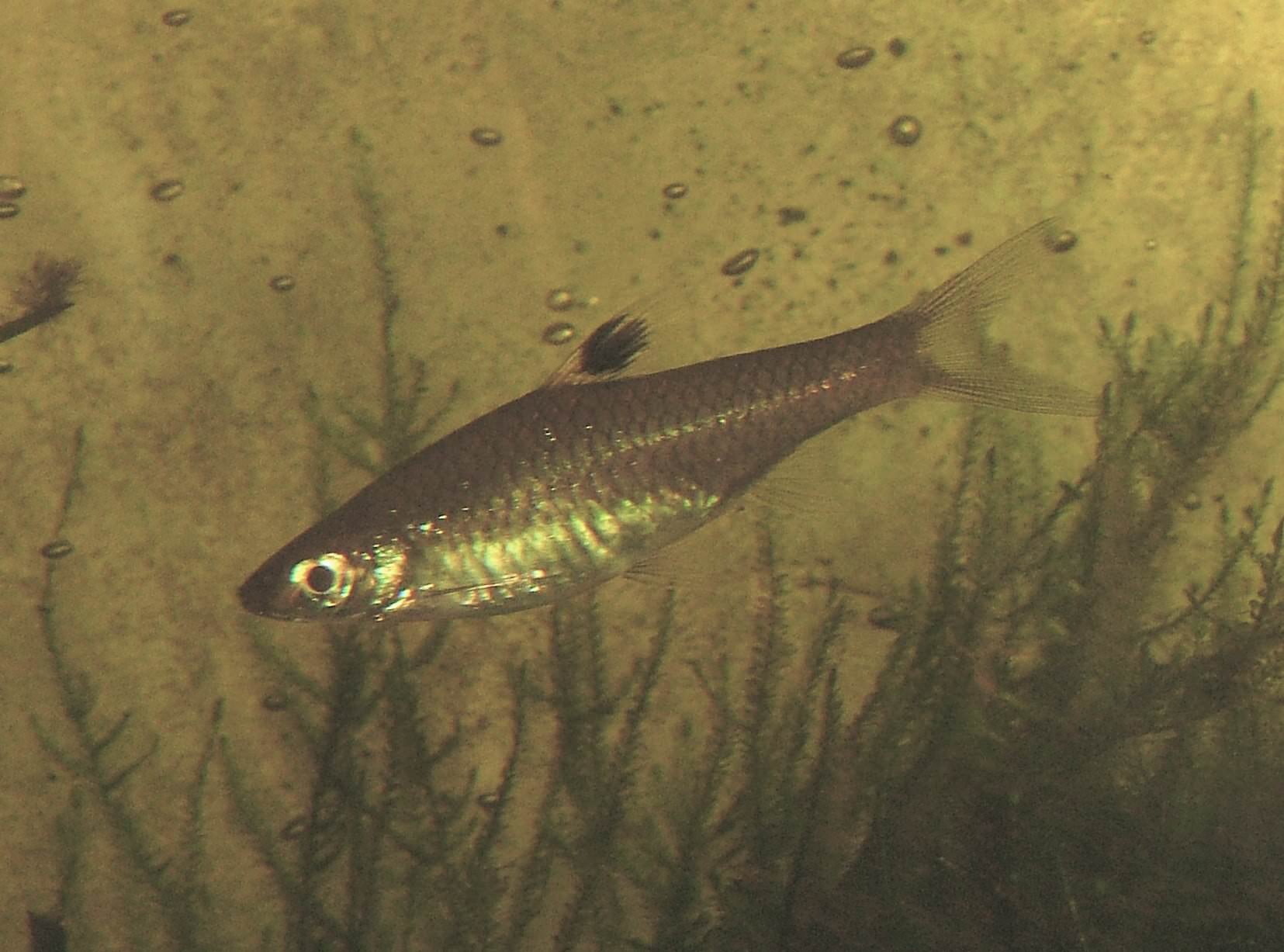
Eyespot rasboras are one of the more popular freshwater aquarium fish due to their unique coloration and patterns.
These fish are a dark black color with a few vertical stripes running down their sides. These stripes can be white, yellow, or orange in color. The most notable feature on these fish is the large eyespot near the base of their tail fin.
This eyespot is usually a different color than the stripes and really stands out. It’s thought that this is used as a form of camouflage or defense against predators.
The rest of the fish is fairly standard as far as rasboras go. They have a long and thin body with a slightly flattened head.
Their fins are all fairly standard as well. They have a dorsal fin that starts about halfway back on their body and an anal fin of similar size. Both of these fins are translucent and streamline.
They have a forked caudal fin that’s slightly taller than it is wide. This fin is also transparent with a few rays running through it.
Eyespot rasboras are a peaceful and social fish that does best in groups. They’re a great addition to any freshwater aquarium!
Lifespan
Eyespot rasboras have a lifespan of 3-5 years.
The lifespan of an eyespot rasbora can be impacted by a number of things. The quality of the water they’re kept in, for example, is very important.
If the water is too warm or too cold, or if the pH is off, it can shorten their lifespan.
They’re also very sensitive to stress, so anything that causes them undue stress (bad tank mates, for example) can also shorten their lifespan.
Size
Rasboras are small fish, and the Eyespot rasbora is certainly no exception! Adults only grow to be about 1.5 inches in length.
Tank
Tank Size
The recommended minimum tank size for Eyespot Rasboras is 10 gallons. This is assuming you’re keeping them in a school of at least 5 or 6 fish (which you should).
We personally recommend a slightly larger tank if you can accommodate it. Every extra space will make a big difference and allow you to keep a larger school or more tank mates if you’re interested in a community tank.
Water Parameters
The Eyespot rasbora is a tropical fish that requires warm water to thrive. They’re also pretty sensitive to ammonia and nitrites, so you’ll need to make sure the water is well-filtered and frequently tested.
Here are a few basic water parameters to help create a healthy environment for your eyespot rasboras.
- Water temperature: 72 to 82 degrees Fahrenheit
- pH levels: 6.0 to 7.8
- Water hardness: 2 to 12 dGH
- Alkalinity Levels: 4-8 dKH
What To Put In Their Tank
Eyespot rasboras are a schooling fish, so you’ll need to purchase at least six of them. They’re not too fussy when it comes to their habitat as long as there’s plenty of space for them to swim around in.
We recommend a gravel substrate with some rocks and driftwood thrown in for decoration. These fish like to spend time near the bottom of the tank, so the gravel will give them something to sift through.
As for plants, they’re not going to eat them but they might uproot them while swimming around. If you want to include some vegetation we recommend fast-growing plants that can bounce back easily (like hornwort or water wisteria).
You don’t need to go overboard with the decorations in their tank. They’re not going to hide away so a couple of pieces of driftwood and some rocks should suffice.
Common Diseases
The eyespot rasbora is a pretty hardy fish, but that doesn’t mean they don’t get sick from time to time. There are a few diseases that these fish are particularly susceptible to.
The most common one is ich. This is a pretty widespread disease that can affect a lot of different species of fish. It’s caused by a parasite that attaches to the skin and gills of your fish.
The most obvious symptom of ich is the presence of white spots on the body of your fish. If you notice this, it’s important to take action immediately.
Ich can be treated, but it’s important to do it quickly. The longer you wait, the more severe the disease will become, and it could eventually kill your fish.
Another disease that eyespot rasboras are prone to is “gill flukes”. This is a parasitic infection that affects the gills of your fish.
The most common symptom of this disease is excessive mucus production. This will cause your fish to have trouble breathing, and it can eventually lead to death.
If you notice this symptom, it’s important to take action immediately and consult a vet.
Behavior & Temperament
Eyespot rasboras are schooling fish, so they do best when kept in groups of six or more. This is especially important when they’re young. If they’re not in a school, they can become stressed, which weakens their immune system and makes them susceptible to disease.
As far as temperament goes, these fish are relatively peaceful. They’re not known to nip at other fish or attack them. The only time they may become aggressive is if they feel threatened.
Eyespot rasboras are active fish that enjoy swimming around the tank. They’re constantly on the move, so they need a lot of space to roam. A 20-gallon tank is the minimum size you should get for a group of six fish.
These fish are also known to be jumpers, so it’s important to have a tight-fitting lid on your tank.
Tank Mates
Eyespot rasboras are peaceful and make for ideal community fish. They get along with most species and don’t pose a threat to anything in the tank.
These fish are also small and typically stay at the mid to top levels of the water column. As a result, you can mix and match with a wide variety of species.
Here are some eyespot rasbora tank mates that tend to work well:
- Guppies
- Mollies
- Tetras
- Platies
- Swordtails
- Corydoras Catfish
- loaches
Breeding
Eyespot rasboras are another species of fish that don’t require much intervention when it comes to breeding. These fish reach maturity around 6 months of age and will start to breed on their own if given the right habitat.
Eyespot rasboras prefer to lay their eggs on plant leaves. So, if you want to increase the chances of breeding, make sure to add plenty of live plants to the tank.
The water temperature should be between 72 and 82 degrees Fahrenheit. The pH should be around 6.5.
When ready, the female will lay her eggs on the underside of a plant leaf. The male will then fertilize them. After that, the eggs will hatch in about 24 hours.
The fry will be very small, so you’ll need to feed them live foods. Baby brine shrimp or microworms are a good option.
As they grow, you can start to feed them crushed-up flake food. Keep an eye on the water quality and do your best to keep the tank clean.
Conclusion
The Eyespot Rasbora is a great fish for beginner aquarists. They’re easy to care for and don’t require a lot of special attention.
They’re also a beautiful fish that will add some color and life to your tank. We highly recommend them!

